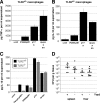Growth of Yersinia pseudotuberculosis in mice occurs independently of Toll-like receptor 2 expression and induction of interleukin-10
- PMID: 17420232
- PMCID: PMC1932928
- DOI: 10.1128/IAI.01497-06
Growth of Yersinia pseudotuberculosis in mice occurs independently of Toll-like receptor 2 expression and induction of interleukin-10
Abstract
Pathogenic Yersinia translocates effector proteins into target cells via a type III secretion system (TTSS), modulating the host immune response. A component of the TTSS translocon, LcrV, has been implicated in preventing inflammation through Toll-like receptor 2 (TLR2) by inducing expression of the anti-inflammatory cytokine interleukin-10 (IL-10). TLR2(-/-) mice were reported to be less susceptible to the enteropathogen Yersinia enterocolitica. To determine whether TLR2 also plays a role in recognition of the enteropathogen Yersinia pseudotuberculosis and whether this results in an immune response that is detrimental to the host, we evaluated the macrophage cytokine response to live Y. pseudotuberculosis and analyzed the susceptibility of TLR2(-/-) mice to enteropathogenic Yersinia. We find that Yersinia induction of macrophage IL-10 occurs independently of TLR2 and LcrV and is blocked by the TTSS. In particular, the TTSS effector protein YopJ, which inhibits production of the inflammatory cytokine tumor necrosis factor alpha (TNF-alpha), also inhibits IL-10 expression. Consistent with these results, IL-10 is undetectable in Y. pseudotuberculosis-infected mouse tissues until advanced stages of infection. In addition, we find that TLR2(-/-) mice (derived independently from those used in previous studies) do not display altered susceptibility to enteropathogenic Yersinia compared to wild-type mice. Tissue levels of IL-10, as well as the inflammatory cytokines TNF-alpha, IL-6, and gamma interferon and the chemokine macrophage chemotactic protein 1, are similar in TLR2(+/+) and TLR2(-/-) mice during enteropathogenic Yersinia infection. Therefore, the absence of TLR2 alone does not affect the cytokine response of macrophages to, or the in vivo growth and survival of, enteropathogenic Yersinia.
Figures





References
-
- Adib-Conquy, M., P. Moine, K. Asehnoune, A. Edouard, T. Espevik, K. Miyake, C. Werts, and J. M. Cavaillon. 2003. Toll-like receptor-mediated tumor necrosis factor and interleukin-10 production differ during systemic inflammation. Am. J. Respir. Crit. Care Med. 168:158-164. - PubMed
-
- Asadullah, K., W. Sterry, and H. D. Volk. 2003. Interleukin-10 therapy—review of a new approach. Pharmacol. Rev. 55:241-269. - PubMed
Publication types
MeSH terms
Substances
Grants and funding
LinkOut - more resources
Full Text Sources
Molecular Biology Databases
Research Materials

